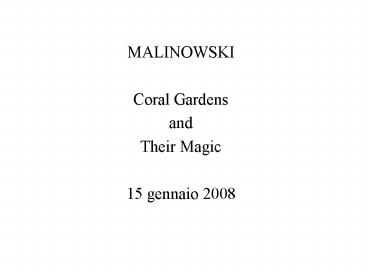MALINOWSKI PowerPoint PPT Presentation
1 / 17
Title: MALINOWSKI
1
- MALINOWSKI
- Coral Gardens
- and
- Their Magic
- 15 gennaio 2008
2
- Ethnography (???? ethnos people and ???fe??
graphein writing) is the genre of writing that
presents varying degrees of qualitative and
quantitative descriptions of human social
phenomena, based on fieldwork. Ethnography
presents the results of a holistic research
method founded on the idea that a system's
properties cannot necessarily be accurately
understood independently of each other. The genre
has both formal and historical connections to
travel writing and colonial office reports.
Several academic traditions, in particular the
constructivist and relativist paradigms, employ
ethnographic research as a crucial research
method. Many cultural anthropologists consider
ethnography the essence of the discipline
3
- The linguistic problem before the ethnographer
is to give as full a presentation of language as
of any other aspect of culture. (p. vii) - Who is the ethnographer?
- What is language to ethnography?
- What does M. mean by the pre-literate stage of
language?
4
- To study language out of its context is FUTILE.
- What is the function of language? (viii)
- Why does M. criticizes traditional approaches to
language? - Vs. Grammarians
- Vs. Phylologists
- He claims for an anthropological approach to
language.
5
- What is the role of the Anthropologist in
studying language? (viii-ix) - to give a full description of language as an
aspect and ingredient of culture - He compares the work of the anthropologist to
that of the missionary.
6
- He feels the need to present language woven into
a continuous story ? intertextuality,
interdiscursivity - What are his sources?
- Other authors, scholars, researchers ? theory
(x-xi) - His linguistic experiences in the field (x-xi)
- The method of the ethnographer (p. 3)
7
Language as Tool, Document and Cultural Reality
- language is the ethnographers most important
tool (p. 4) - What is vernacular?
- Try to apply Ms view to technical and scientific
language. - What does he mean by definition texts? (p. 4)
- What is their communicative function (Jakobson)?
- How are they constructed? (p. 5)
8
- Language stands in a definite relation to the
life of the people who speak it and to their
mental habits and attitudes. From this point of
view it provides us with the most important
documents illustrating types of human behaviour
other than linguistic. (p. 6) - He identifies different types of texts within the
Trobriand community magical formulae, sayings. - They perform different functions
- they comment on activities
- they direct young to do things
9
- Both lexical (antonyms) and grammatical
(possessive pronouns) items perform a specific
functional role ? it can be considered as botth a
document and a tool - Language is a means to assess mental processes ?
there exists a relation between word and idea,
verbal and mental - BUT language does not simply reflect the mental
reality of man. It is above all a cultural force
that plays an important pragmatic part in human
action. (p. 7)
10
- Mans actions are carried out by means of a
combination of speech and bodily activity (p. 8) - work would be impossibile without speech.
Speech again is meaningless without the context
of the activity in which it is enveloped - He introduces the relation between language and
context of action and situation (p. 8) - Question what is the role fo this in
text-writing and translation as far as technical
texts are concerned?
11
- FUNDAMENTAL Ms methodology applies not only to
the Trobriand language but also to the human
speech as a whole. (p. 8) - Words are part of action and they are
equivalents to actions. (p. 9) - Thus, Ms methodology aims to
- Correlate the study of language with that of
other activities - Interpret the meaning of each utterance within
its actual context - Define meaning in terms of experience and
situation.
12
- All types of language contain the pragmatic
dimension. He mentions the example of magic
formulae. - What does he mean by magic? The sacredness of
words. - Language is a type of human behaviour and a
purely conventional element (p. 10) ? words are
used to represent conventional actions too.
13
- On translation
- He opposes word-for-word translation to free
translation (p. 10-11). - Why is literal translation not sufficient?
- The sentence is at times a self-contained
linguistic unit, but not even a sentence can be
regarded as a full linguistic datum. To us, the
real linguistic fact is the full utterance within
its context of situation (p. 11)
14
- On literal translation
- It fails because of untranslatability of words
from one culture to another. - There is no equivalence, no one-to-one
correspondence between words of two different
cultures. - When we translate we re-create the original into
something completely new. We do not translate
word-for-word but we translate whole contexts
(pp. 11-12)
15
- Why are certain words untranslatable?
- Because they fit into their culture and into that
only. - Neither are common words easy to translate think
of Jakobsons example of cheese. - Different translations involve different
contexts. Texts vary according to the context in
which they are used. - There are also translation difficulties with
numbers, body parts, adverbs and conjunctions.
16
- Translation is not the mere rendering of words
and/or expressions from one language into
another. - The translator has to account for different
cultural issues and systems of values
17
- A. Whats your name, boy?
- B. Dr. Poussaint. Im a physician.
- A. Whats your first name, boy?
- B. Alvin.

